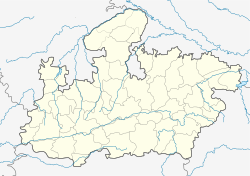Bhimbetka rock shelters
| Rock Shelters of Bhimbetka | |
|---|---|
| Name as inscribed on the World Heritage List | |
 |
|
| Location | India |
| Type | Cultural |
| Criteria | (iii)(v) |
| Reference | 925 |
| UNESCO region | South Asia |
| Coordinates | 22°55′40″N 77°35′00″E / 22.92778°N 77.5833°ECoordinates: 22°55′40″N 77°35′00″E / 22.92778°N 77.5833°E |
| Inscription history | |
| Inscription | 2003 (27th Session) |
The Bhimbetka rock shelters are an archaeological site of the Paleolithic, exhibiting the earliest traces of human life on the Indian Subcontinent, and thus the beginning of the Indian Stone Age. It is located in the Raisen District in the Indian state of Madhya Pradesh, near Abdullaganj town and inside the Ratapani Wildlife Sanctuary. At least some of the shelters were inhabited by Homo erectus over 100,000 years ago. Some of the Stone Age rock paintings found among the Bhimbetka rock shelters are some 30,000 years old. The caves also deliver early evidence of dance. They were declared a World Heritage Site in 2003.
The name Bhimbetka (भीमबेटका) is associated with Bhima, a hero-deity of the epic Mahabharata. The word Bhimbetka is said to derive from Bhimbaithka (भीमबैठका), meaning "sitting place of Bhima".
The Rock Shelters of Bhimbetaka (or Bhim Baithaka) lies 9 km from Obedullaganj city in the Raisen District of Madhya Pradesh and 45 kilometers south of Bhopal at the southern edge of the Vindhya hills. South of these rock shelters are successive ranges of the Satpura hills.
The entire area is covered by thick vegetation, has abundant natural resources in its perennial water supplies, natural shelters, rich forest flora and fauna and bears a striking resemblance to similar rock art sites such as Kakadu National Park in Australia, the cave paintings of the Bushmen in Kalahari Desert and the Upper Paleolithic Lascaux cave paintings in France.
...
Wikipedia


